10 Interesting facts about Mount Vesuvius
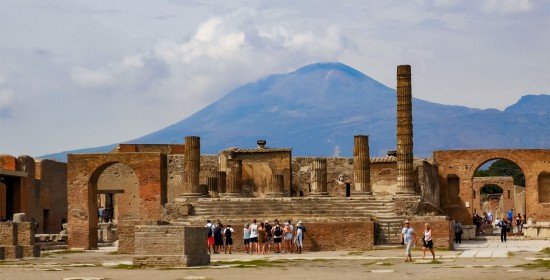
Buongiorno and welcome to Stefano Rome Tours.
The impressive Mount Vesuvius is an ever-present view on our tours to Pompeii and Amalfi Coast from Rome. Its presence serves as a steady reminder of the fateful day in 79AD when its catastrophic eruption entombed nearby towns like Pompeii and Herculaneum. Vesuvius is the only active volcano on Europe’s mainland and is considered to be one of the world’s most dangerous volcanos.
Mount Vesuvius’ powerful destruction also, ironically, preserved almost intact the towns and villages as if they froze in time. Centuries of discoveries during the enduring excavation efforts by generations of archaeologists and researchers yielded significant knowledge about ancient Roman architecture, culture, city planning, staples of ancient Romans’ diet, and more!
In this travel blog, we will focus on 10 interesting facts about Mount Vesuvius, one of the world’s most famous volcanoes!
-
Where in Italy is Mount Vesuvius Located?
-
What type of volcano is Mount Vesuvius?
-
How old is Mount Vesuvius?
-
How tall is Mount Vesuvius?
-
Mount Vesuvius is actually two volcanoes
-
When did Vesuvius erupt when it destroyed Pompeii and Herculaneum?
-
How Mount Vesuvius Destroyed Pompeii
-
How often does Mount Vesuvius erupt?
-
Is Mount Vesuvius still active today?
-
Will Mount Vesuvius erupt again?
10 Interesting facts about Mount Vesuvius
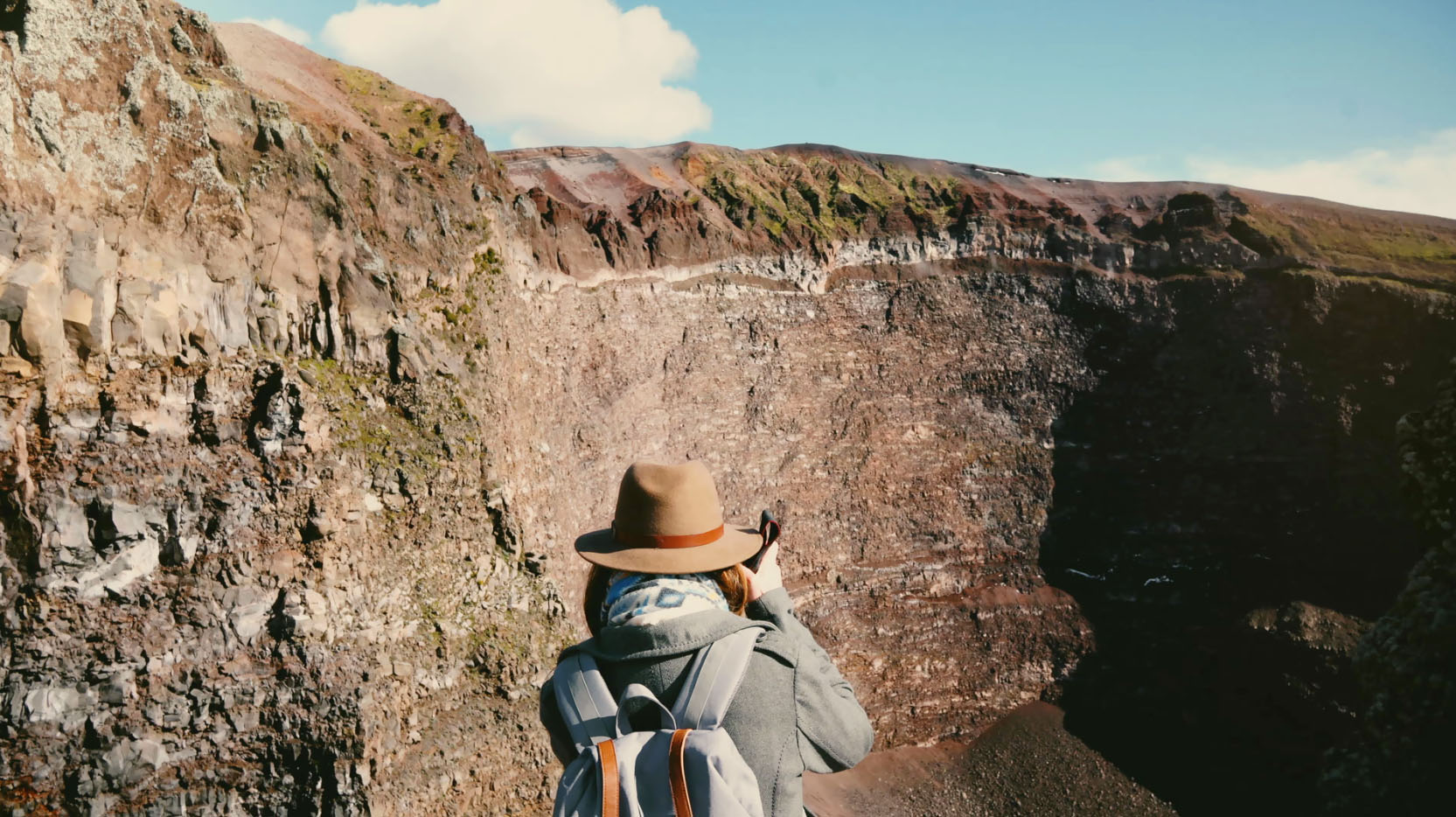
-
Where in Italy is Mount Vesuvius Located?
Mount Vesuvius is located on Italy’s west coast overlooking the Bay of Naples.
-
What type of volcano is Mount Vesuvius?
Mount Vesuvius is classified as a complex stratovolcano because of its unpredictable and catastrophic eruptions that generally involve explosive emission of andesite lava and pyroclastic flows. A pyroclastic flow is a high-density combination of hot lava rocks, pumice, ash, and volcanic gas.
Vesuvius is part of the Campanian volcanic arc that formed over a subduction zone that was created by the convergence of the Eurasian and African tectonic plates. Subduction is a geological process in which oceanic tectonic plates collide with continental plates and slide beneath them. This subduction zone extends the length of the Italian peninsula and is the source of other significant volcanoes like Mount Etna and Stromboli.
-
How old is Mount Vesuvius?
The area around Mount Vesuvius has been subject to volcanic activity for about 400,000 years.
Vesuvius was formed in the caldera of an ancient volcano called Mount Somma. Mount Somma collapsed about 17,000 years ago in its final eruption, which formed the caldera. Vesuvius was formed incrementally in the caldera during the final collapse. Parts of Mt. Somma is still visible on the north and northeast sides of Vesuvius.
-
How tall is Mount Vesuvius?
The height of the volcano can change after major eruptions. In 2013, the height of the cone measured 4,203 feet (1,281 meters).
-
Mount Vesuvius is 2 volcanoes together
The Vesuvius is a typical example of a volcano within a volcano made by an outer broken cone of Mount Somma.
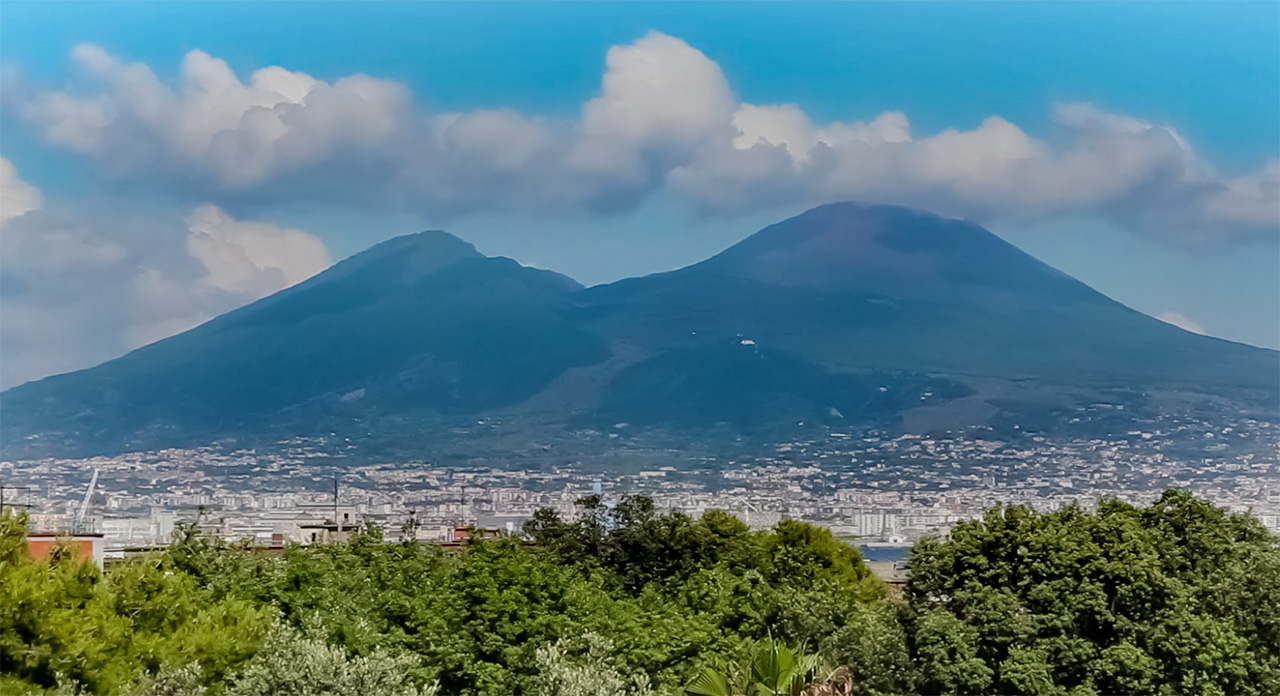
The current volcano structure is the result of the merging of two cones that formed as a result of a powerful eruption of Mount Somma. The older external cone is known as Mount Somma, and the younger internal cone is known as Vesuvius.
The two cones are separated by a depression called Valle del Gigante. This depression is also subdivided into the Atrio del Cavallo to the west and the Valle dell’ Inferno to the east. The origin of the Somma-Vesuvius volcanic structure dates back to approximately 400,000 years ago.
-
When did Mount Vesuvius Erupt when it destroyed Pompeii?
In the Ancient Roman times of Pompeii, Mount Vesuvius erupted in 79 AD.
Traditionally based on letters written by Pliny the Younger, the Mount Vesuvius eruption occurred on August 25-27 after the annual Vulcanalia festival held to honor Vulcan, the pagan god of fire.
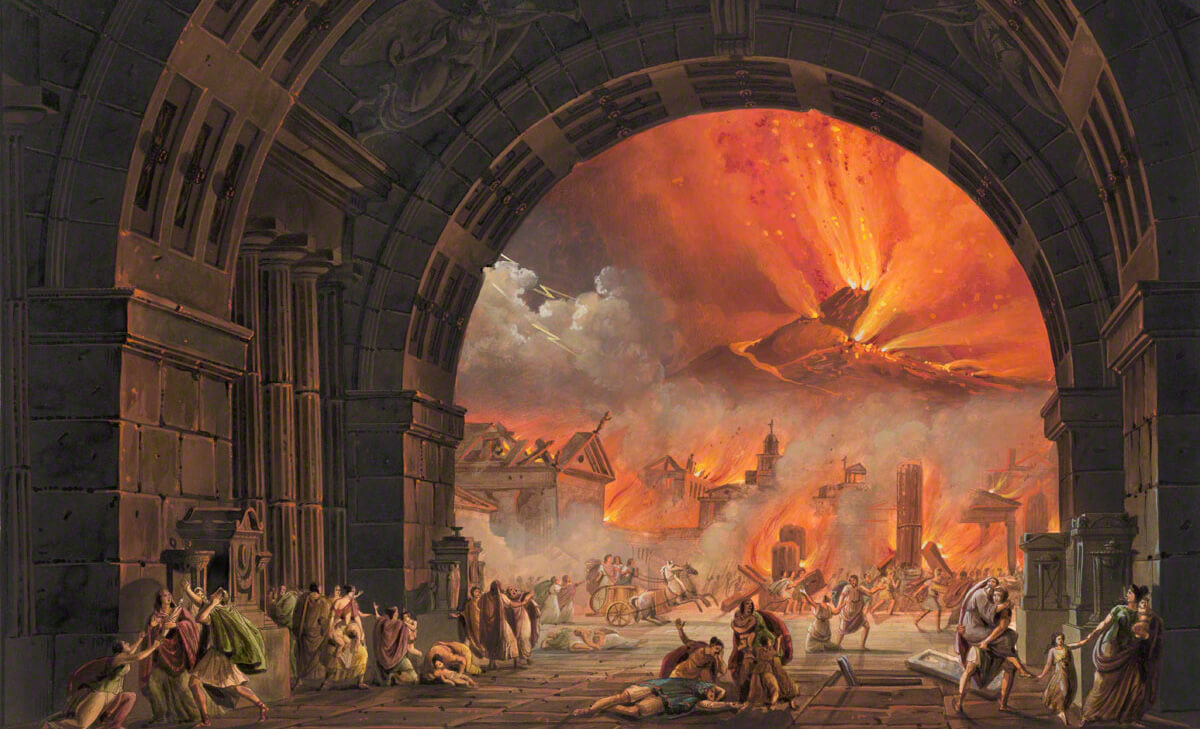
However, in light of many discoveries, scholars argue that the date of the eruption to October or November of the same year. Why? For one, heavy clothing worn by some of the citizens is still visible in plaster casts. Uncovered braziers that were used for both cooking and heating may not have been used in the heat of Italy’s late August.
A charcoal inscription is evident in new excavations was dated 16 days before the “calends” of November in the old Roman calendar style. This date translates to October 17 according to our modern calendar. Since the inscription was made in fragile charcoal that generally does not survive long on a wall surface, it offers the probability that it was made in 79 AD just before the eruption and then was preserved buried under the compacted ash.
Autumn fruits like pomegranates and walnuts were also discovered in the ruins.
The question is now obvious: how could Pliny the Elder have been wrong when he wrote the eruption occurred on August 24?
The original letters he wrote his letters to Tacitus approximately 20 years after the 79 AD eruption have not survived. Our contemporary reading of Pliny’s letters is based on translations and transcriptions made over the centuries which could have created confusion over the ancient and modern system of counting days.
-
How did Mount Vesuvius erupt in 79 AD?
Mount Vesuvius instantly decimated an entire local civilization and turned it into ash when it erupted in 79AD, one of the deadliest in Europe’s history.
When it erupted into the stratosphere, Vesuvius ejected molten rock, pulverized pumice, and hot ash at 1.5 million tons per second, releasing 100,000 times the thermal energy of an atomic bomb.
A harbinger for the 79 AD eruption was a strong earthquake that occurred earlier in 62 AD. As recorded in a biography of Nero and by Tacitus (one of the greatest Roman historians), a powerful earthquake took place while Nero was performing for the first time in a Naples public theater. Both Pompeii and Herculaneum sustained significant mange due to the earthquake, and restorations were still incomplete when Vesuvius erupted 17 years later.
Then, a series of small earthquakes were felt for 4 days before the catastrophic eruption but were largely ignored as the locals were accustomed to such minor tremors in that region.
Pliny the Younger was a lawyer, author, and magistrate of Ancient Rome, and the nephew of Pliny the Elder wrote that they "were not particularly alarming because they are frequent in Campania".
Later, Pliny the Younger witnessed the eruption and recounted the event in his letter to Tacitus about 2 decades later:
"At that time my uncle [Pliny the Elder] was at Misenum in command of the fleet. About one in the afternoon, my mother pointed out a cloud with an odd size and appearance that had just formed. From that distance it was not clear from which mountain the cloud was rising, although it was found afterwards to be Vesuvius. The cloud could best be described as more like an umbrella pine than any other tree, because it rose high up in a kind of trunk and then divided into branches. I imagine that this was because it was thrust up by the initial blast until its power weakened and it was left unsupported and spread out sideways under its own weight. Sometimes it looked light coloured, sometimes it looked mottled and dirty with the earth and ash it had carried up….”
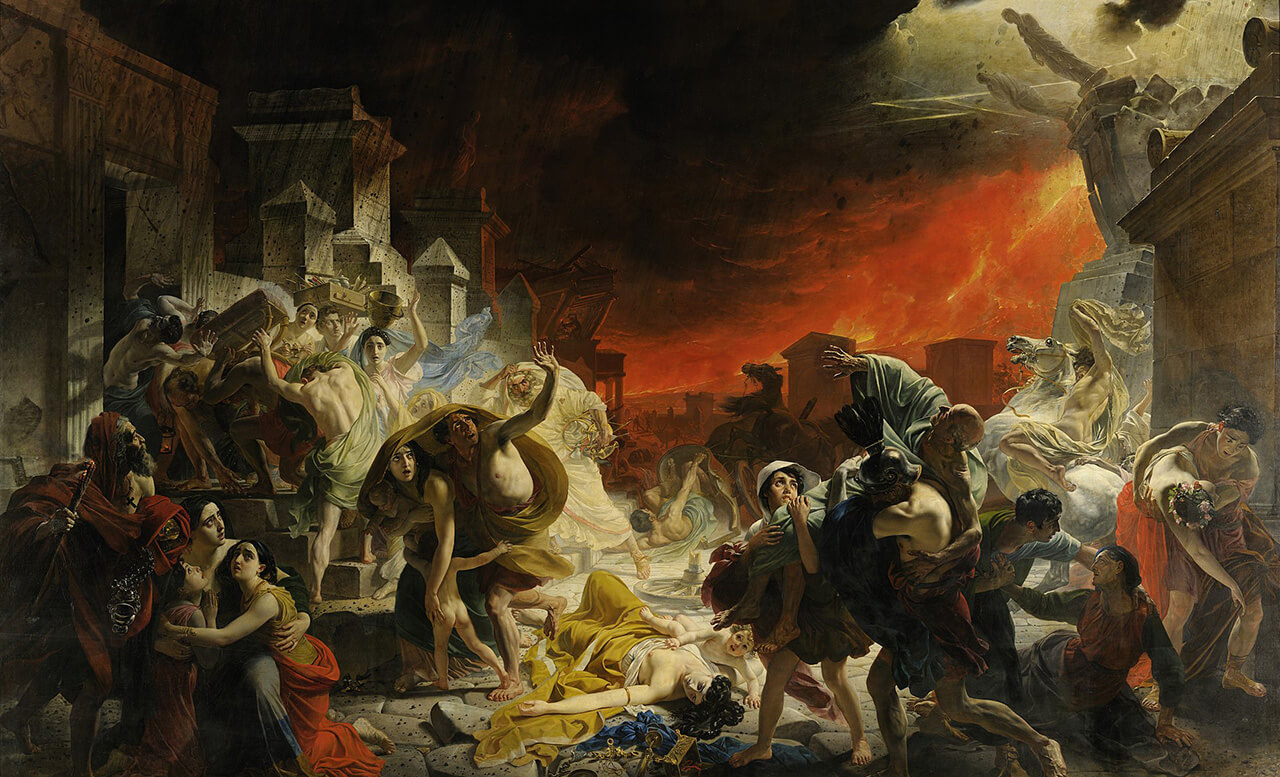
In his letters, Pliny the Younger described his uncle Pliny the Elder rushing ashore from Misenum to discover the cause of the unusual cloud formation of the volcanic phenomena and to rescue a friend and his family by ship. "Fortune favours the brave", he is thought to have said, "take me to Pomponianus" who lived in Stabiae across the Bay of Naples. He was consequently overcome by the fumes from the volcanic activity and perished at Stabiae.
Contemporary volcanologists use the term “Plinian” to describe large-volume powerful volcanic eruptions that spew quickly-expanding clouds of rock, ash, and gases into the atmosphere. A recent example of “Plinian eruption” is the Mount St Helens eruption in 1980.
-
How did Mount Vesuvius Destroy Pompeii and Herculaneum?
How Pompeii was destroyed by Mount Vesuvius
Vesuvius destroyed Pompeii in just two days (about 25 hours) by burying the city in volcanic ash that preserved that cruel moment as a snapshot of the life of a Roman city.
Explosions and eruptions began after mid-day, shooting a tall cloud of lava and ash into the stratosphere blocking the sun. Powerful tremors caused buildings to crumble.
Pliny the Younger recalled in this letter: "The darkness came back and ash began to fall again, this time in heavier showers. We had to get up from time to time to shake it off, or we would have been crushed and buried under its weight. I could boast that I never expressed any fear at this time, but I was only kept going by the consolation that the whole world was perishing with me.”
At that time, most Pompeiians still had time to flee and escape, but due to their ignorance of volcanoes, many did not. The locals did not know Vesuvius was a volcano and didn’t even have a name for “volcano” as they never experienced one. For the residents who stayed behind, conditions rapidly grew worse. Falling ash choked the air making it difficult to breathe, and buildings collapsed under its weight.
Pliny the Younger wrote: “You could hear the shrieks of women, the wailing of infants, and the shouting of men; some were calling their parents, others their children or their wives,"
Fragments of ash, pumice, and other volcanic debris poured down on Pompeii swiftly covering the city, trapping people in their houses, and causing roofs to collapse.
The following morning, a 100-mile-an-hour pyroclastic surge blasted rock and clouds of superheated gas down the mountain slope devouring everything in its path as it made its way to Pompeii. It is believed most of the residents who have not fled died instantly as the superheated air burned their lungs and contracted their muscles, and left their bodies in semi-curled positions.
It is estimated that it took about 15 minutes to kill the inhabitants and entomb Pompeii 6-7 meters beneath millions of tons of volcanic ash, erasing the wealthy Roman cities of Pompeii and Herculaneum from existence.
Although the total death toll of Vesuvius’ eruption is still unknown, it is estimated that about 2,000 Pompeiians have died, causing more than 16,000 people in the area to perish overall.
Survivors who managed to escape the destruction may have returned back in search of lost relatives or personal belongings, but there was nothing left to find. Thus, they resettled in nearby towns such as Neapoli, Capua, Cumae, Ostia, Paestum, Salerno, Puteoli, and others.
Learn more about Surprising Things about Pompeii most people don’t know on our travel blog, or book a private guided tour of Pompeii on our Pompeii tours from Rome to Sorrento.
How Mount Vesuvius Destroyed Herculaneum in 79 AD
When Vesuvius erupted, Herculaneum experienced two phases of its eruption.
In the first phase, a colossal column of volcanic ash and rocks exploded into the sky before falling back down to the ground like rain. Due to the wind’s southeast direction, this storm of pumice and ash fell over Pompeii. Herculaneum was not initially affected by this phase, which allowed many people to escape before the next phase began.

Their fate, unfortunately, changed for the worse by nighttime when the second phase of Vesuvius’ eruption of superheated pyroclastic flows of molten rock of intense 400 degrees Celcius rolled down the mountain slope at 100 kph covering Herculaneum and killing everything in its path. This infernal surge was so fiercely hot it carbonized wood and caused the sea to boil when it reached the seaside.
While it took the volcanic eruption 3 days to destroy Pompeii, Herculaneum was almost instantly destroyed in about 2 hours.
-
How often does Mount Vesuvius erupt?
Recently, archaeologists discovered that Mount Vesuvius erupted with even more disruptive force approximately 3,780 years ago transforming thousands of miles of the landscape into a desert for more than two centuries. Deeply embedded footprints in the surrounding area were uncovered where inhabitants were clearly taken by surprise by Vesuvius’ Avellino eruption.
Since Pompeii, Mount Vesuvius has erupted 30 times. A major eruption occurred in 1631 killing 4,000 people and devastating Naples and other villages.
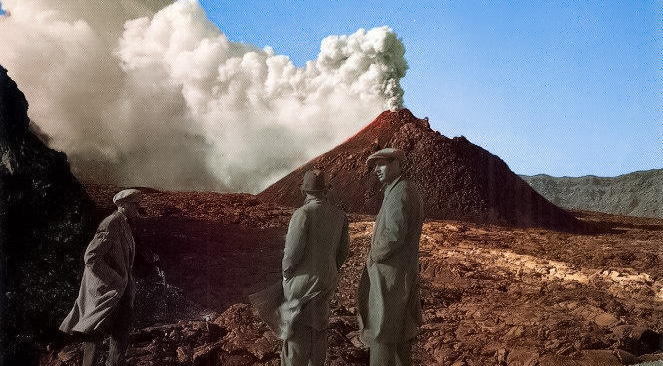
In modern times, Mount Vesuvius last erupted in March 1944. The eruption started on March 17 and lasted for a week and a half with slow-moving lava flow, rock, and ash falling down on San Sebastiano. Although the town was destroyed, about 7,000 citizens were evacuated out of harm’s way with minimal casualties (approximately 26 civilians perished).
-
Is Mount Vesuvius still active today?
In short, YES!
Vesuvius sits on top of a layer of magma deep in the earth that measures 154 square miles.
Mount Vesuvius is continuously under observation as it is the only active volcano on the European continent and is considered to be one of the world’s most dangerous volcanos. Vesuvius Observatory monitors seismic activity, gas emissions, and other indicators 24 hours a day to learn when the volcano might erupt.
-
Will Mount Vesuvius erupt again?
Scientists anticipate that the next eruption could be an incredibly forceful plinean explosion characterized by ejected rock and ash flying at speeds of up to almost 100 miles per hour. Considering its destructive potential, Mount Vesuvius could endanger more than 3 million people in the area and devastate 800,000 people who live in the “red zone” communities surrounding Vesuvius.
Experts advise that emergency plans should also include the city of Naples since a powerful volcanic explosion could eject hazardous burning ash and pumice as far as 12 miles. Due to the unpredictable threat of an eruption, the Italian government created an evacuation plan aimed to clear out the red zone 72 hours before an impending eruption.
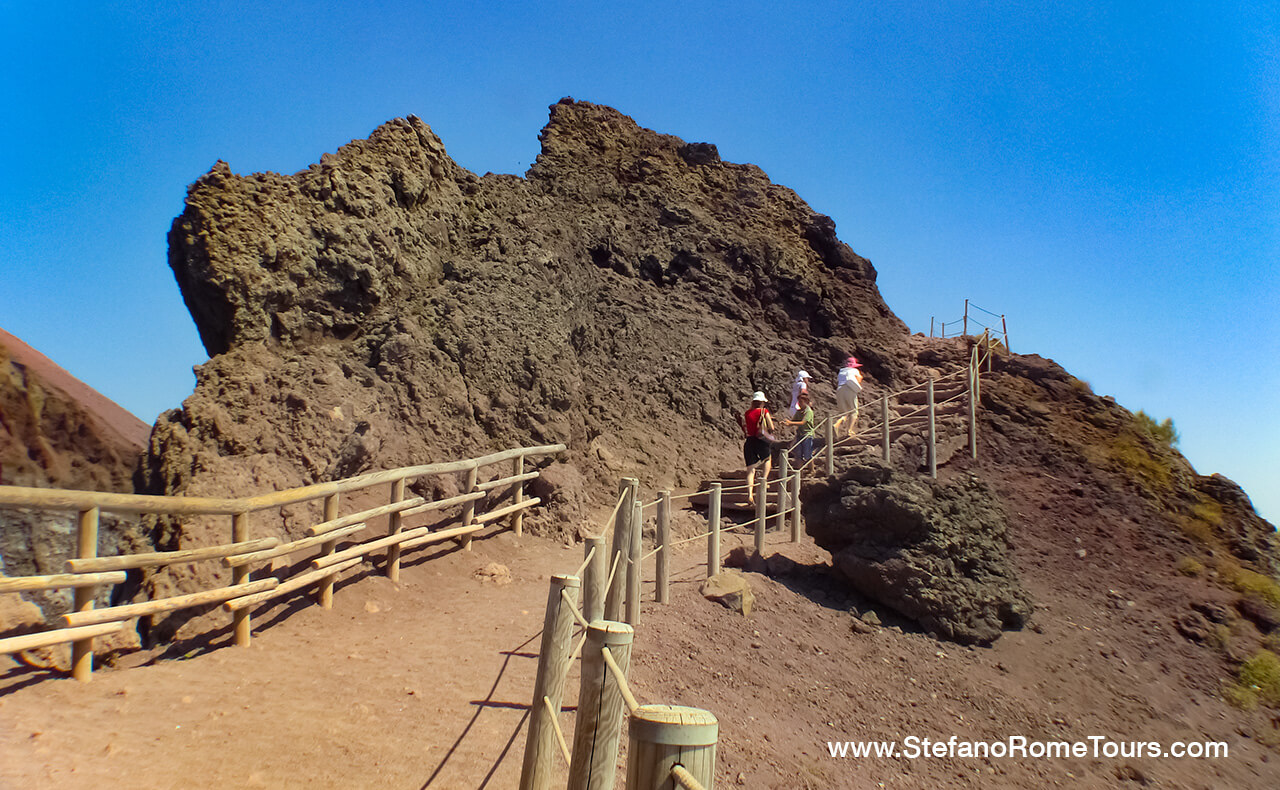
Now that you know these interesting facts about Mount Vesuvius, next time you are in Pompeii, Herculaneum, Naples, Sorrento, or on the Amalfi Coast and see its imposing silhouette, you will gaze upon this volcano with great appreciation, and hope that it will continue to remain docile for centuries to come!
Thank you for reading our travel blog 10 Interesting facts about Mount Vesuvius and for choosing Stefano Rome Tours for your Amalfi Coast and Pompeii tour from Rome. We look forward to showing you amazing places in Italy!
